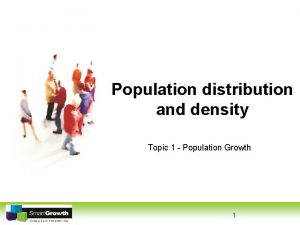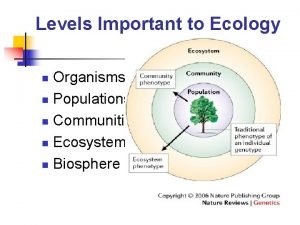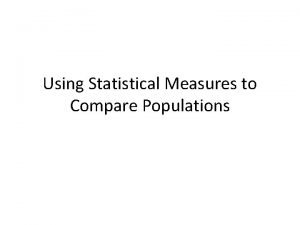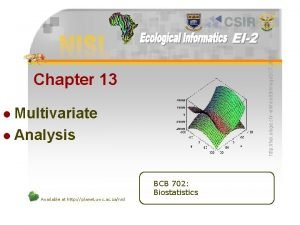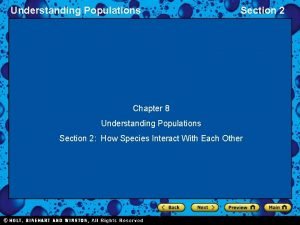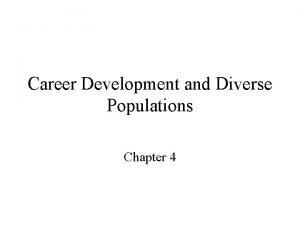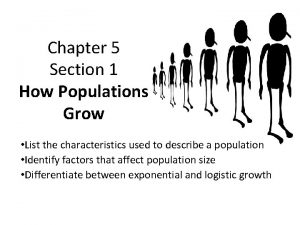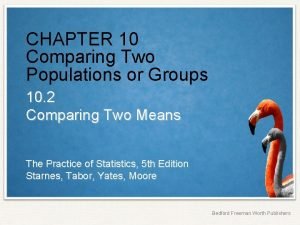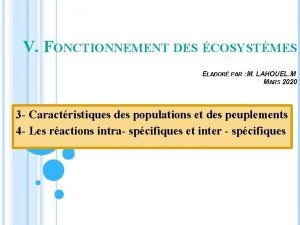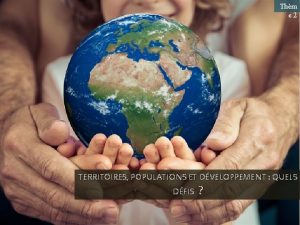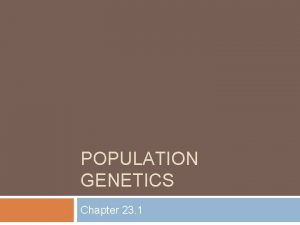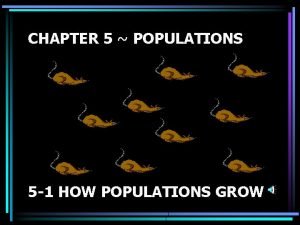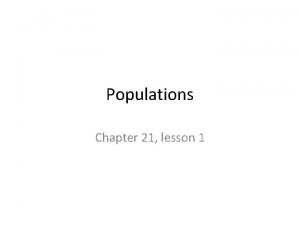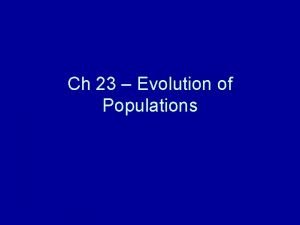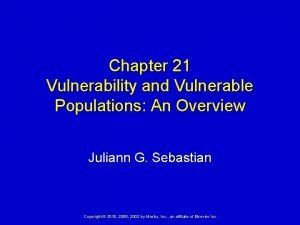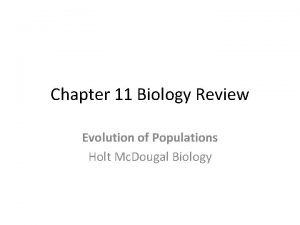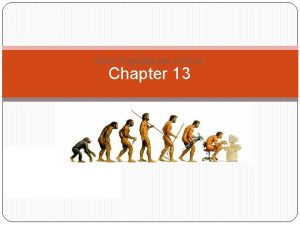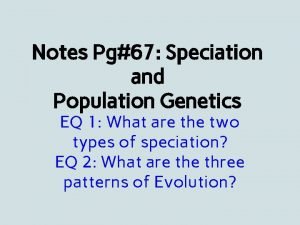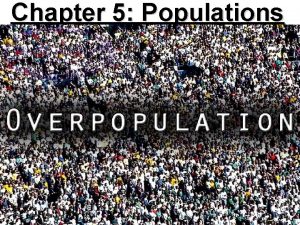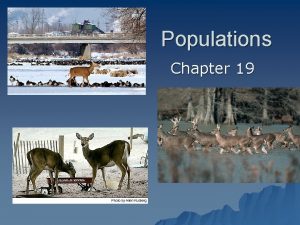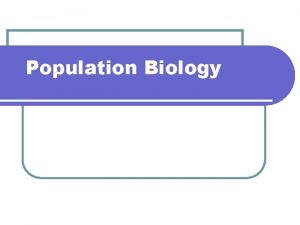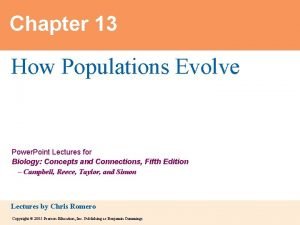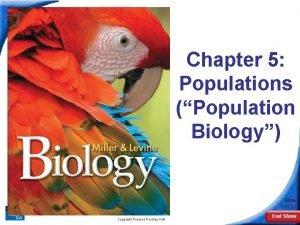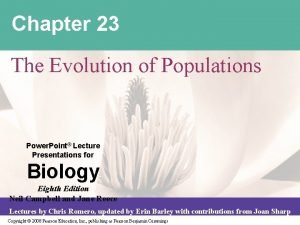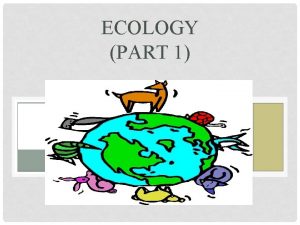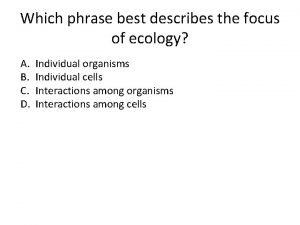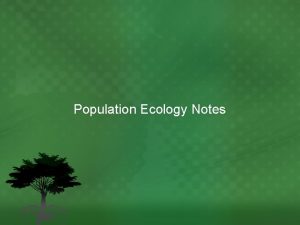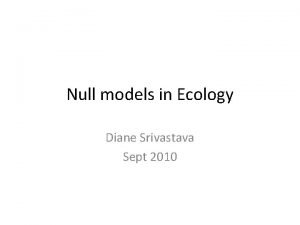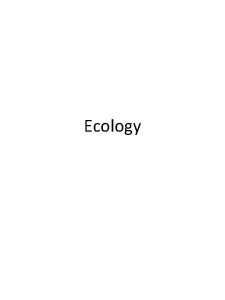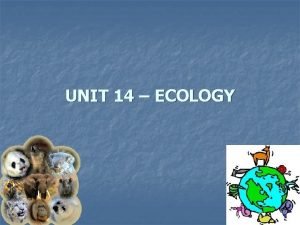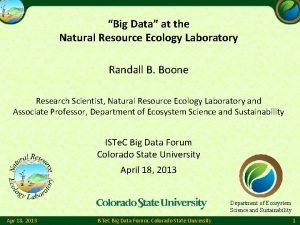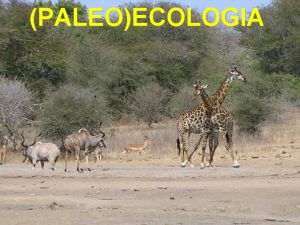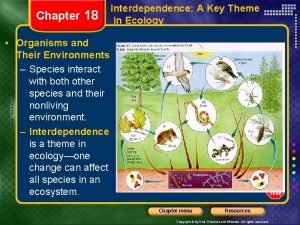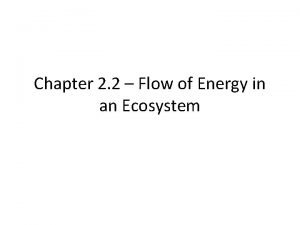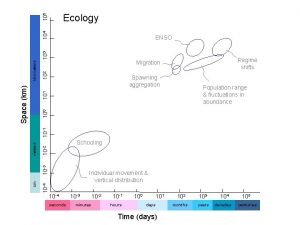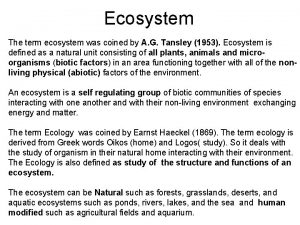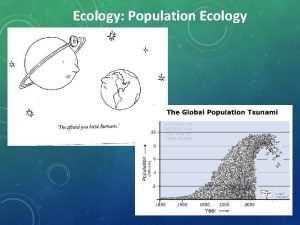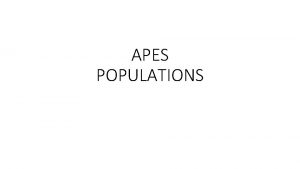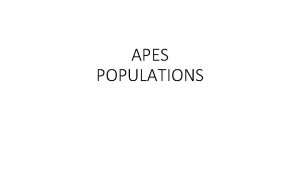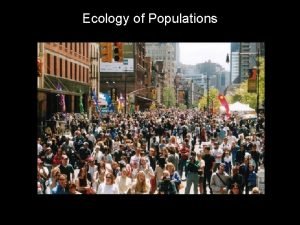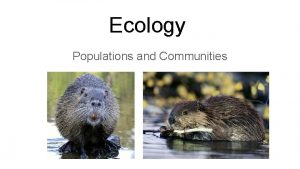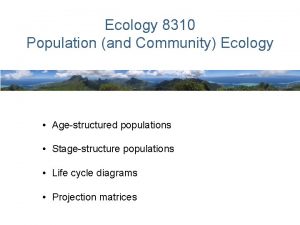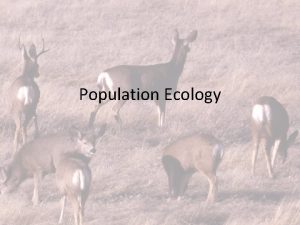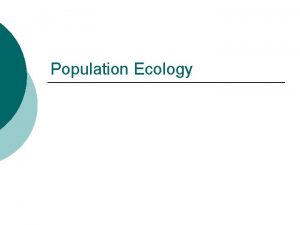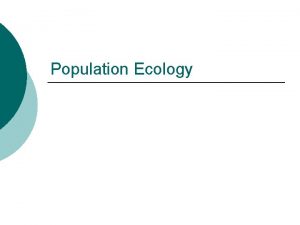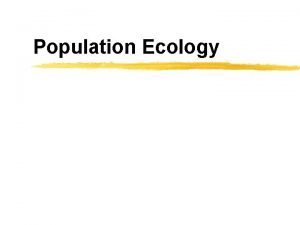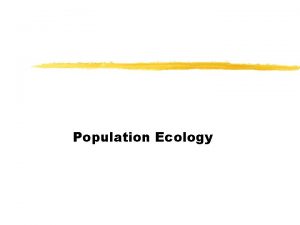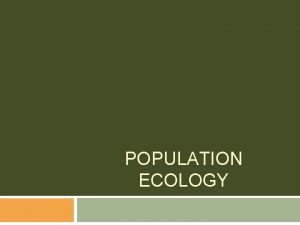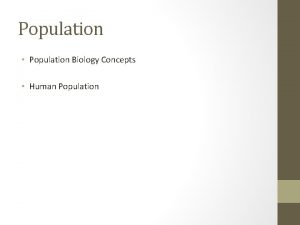54 Population Ecology 54 Population Ecology Populations in















































































- Slides: 79

54 Population Ecology

54 Population Ecology • Populations in Space and Time • Types of Ecological Interactions • Fluctuations in Population Densities • Population Fluctuations • Variations in Species’ Ranges • Managing Populations • Regional and Global Processes Influence Local Population Dynamics

54 Populations in Space and Time • The individuals of a species with a given area constitute a population. • The distribution of the ages of individuals in a population and the way those individuals are distributed over the environment describe the population structure. • Ecologists study population structure at different spatial scales, ranging from local subpopulations to entire species. • The number of individuals of a species per unit of area (or volume) is its population density.

54 Populations in Space and Time • Ecologists are interested in population densities because dense populations often exert strong influences on their own members as well as on populations of other species. • Density of terrestrial organisms is measured as number of individuals per unit area. • Density of aquatic organisms is measured as individuals per unit volume. • For some species such as plants, the biomass or percentage of ground covered may be a more useful measure of density than the number of individuals.

54 Populations in Space and Time • The structure of a population changes continually because of demographic events—births, deaths, immigration, and emigration. • Population dynamics is the change in population density through time and space. • Demography is the study of birth, death, and movement rates that give rise to population dynamics.

54 Populations in Space and Time • Population dynamics can be represented by: • N 1 = N 0 + B – D + I – E § N 1 = number of individuals at time 1 § N 0 = number of individuals at time 0 § B = number of individuals born between time 0 and time 1 § D = number of individuals that died between time 0 and time 1 § I = number of individuals that immigrated § E = number of individuals that emigrated

54 Populations in Space and Time • Life table information can be used to predict future trends in populations. • A cohort is a group of individuals that were born at the same time. • A life table can be constructed by determining the number of individuals in a cohort that are still alive at specific times (the survivorship) and the number of offspring they produced in each time interval.

Table 54. 1 Life Table of the 1978 Cohort of the Cactus Finch on Isla Daphne (Part 1)

Table 54. 1 Life Table of the 1978 Cohort of the Cactus Finch on Isla Daphne (Part 2)

54 Populations in Space and Time • The life table for a cohort of the cactus finch on Isla Daphne in the Galápagos archipelago shows that mortality rates were initially high, leveled off, and again increased as the birds aged. • Mortality rate also fluctuated through the years because survival depends upon seed production, and seed production is correlated with rainfall.

54 Populations in Space and Time • Survivorship curves in many populations fall into one of three patterns. • In some populations (e. g. , humans in the U. S. ), most individuals survive for most of their potential life span and die at about the same age. • In some (e. g. , songbirds), the probability of surviving over the life span is the same once individuals are a few months old. • In species that produce a large number of offspring and provide little parental care, high death rates for the young are followed by high survival rates during the middle of the life span.

Figure 54. 1 Survivorship Curves (Part 1)

Figure 54. 1 Survivorship Curves (Part 2)

54 Populations in Space and Time • The age distribution of individuals in a population reveals much about the recent history of births and deaths. • For example, in the U. S. , population size increased during the “baby boom” of the 1950 s and again during the “baby boom echo” of the 1980 s. • Life tables can help us to understand why population densities change over time and to determine which groups should be the focus of efforts to save rare species.

Figure 54. 2 Age Distributions Change over Time

54 Types of Ecological Interactions • Species interactions fall into several categories. • If both participants benefit from an interaction, the interaction is a mutualism (+/+ interaction). • An example of mutualism is the association between plants and soil fungi called mycorrhizae, or between plants and nitrogen-fixing bacteria. • Corals gain most of their energy from photosynthetic protists. The protists get nutrients when the corals digest animals. • Termites have protists in their gut that digest cellulose; they provide the protists, in turn, with nutrients.

54 Types of Ecological Interactions • If one participant benefits but the other is unaffected, the interaction is a commensalism (+/0 interaction). • Cattle egrets forage for insects near large mammals, and the movements of the large animal flush out insects, which the birds eat. The mammal does not gain or lose anything from this interaction.

Figure 54. 3 Commensalism Benefits One Partner

54 Types of Ecological Interactions • If one participant is harmed but the other is unaffected, the interaction is an amensalism (0/– interaction). • Trees and branches falling from trees damage smaller plants beneath them; this is an example of amensalism.

54 Types of Ecological Interactions • One organism may benefit itself while harming another organism; these interactions are called predator–prey and parasite–host interactions (+/ – interactions). • If two organisms use the same resources and those resources are insufficient for their combined needs, they are in competition (–/– interaction).

Table 54. 2 Types of Ecological Interactions

54 Factors Influencing Population Densities • Species that use abundant resources often reach higher population densities than species that use scarce resources. • Species with small individuals generally reach higher population densities than species with large individuals. • This relationship can be demonstrated by a logarithmic plot of population density against body size for a variety of mammals worldwide.

Figure 54. 4 Population Density Decreases as Body Size Increases

54 Factors Influencing Population Densities • Newly introduced species often reach high population densities. • An example is species introduced into a region where their normal predators and diseases are absent. • Zebra mussels whose larvae were carried from Europe in the ballast water of ships now occupy much of the Great Lakes and Mississippi River drainage. • Complex social organizations (e. g. , ants, termites, humans) may facilitate high densities.

Figure 54. 5 Introduced Zebra Mussels Have Spread Rapidly

54 Fluctuations in Population Densities • If a single bacterium were allowed to grow and reproduce in an unlimited environment, explosive population growth would result. • Within a month, the bacterial colony would weigh as much as the visible universe and would be expanding outward at the speed of light. • But while populations do fluctuate in density, even the most dramatic fluctuations are less than what is theoretically possible.

54 Fluctuations in Population Densities • All populations have the potential for explosive growth because, as the number of individuals in the population increases, the number of new individuals added per unit of time accelerates, even if the rate per capita of population increase remains constant. • If births and deaths occur continuously and at constant rates, a graph of the population size over time forms a J-shaped curve that describes a form of explosive growth called exponential growth.

Figure 54. 6 Exponential Population Growth (Part 1)

Figure 54. 6 Exponential Population Growth (Part 2)

54 Fluctuations in Population Densities • Exponential growth can be represented mathematically: DN/Dt = (b – d)N • DN = the change in number of individuals • Dt = the change in time • b = the average per capita birth rate (includes immigrations) • d = the average per capita death rate (includes emigrations)

54 Fluctuations in Population Densities • The difference between per capita birth rate (b) and per capita death rate (d) is the net reproductive rate (r). • When conditions are optimal, r is at its highest value (rmax), called the intrinsic rate of increase. • rmax is characteristic for a species. • The equation for population growth can be written D/Dt = rmax. N

54 Fluctuations in Population Densities • For limited time periods, some populations may grow at rates close to rmax. • Real populations do not grow exponentially for long because of environmental limitations. • Environmental limitations include food, nest sites, shelter, disease, and predation. • The carrying capacity of an environment (K) is the maximum number of individuals of a species it can support. • Natural population growth more closely resembles an S-shaped curve.

Figure 54. 7 Logistic Population Growth

54 Fluctuations in Population Densities • The mathematical representation of this type of growth (logistic growth) is: DN/Dt = r[(K – N)/K]N • The equation for logistic growth indicates that the population’s growth slows as it approaches its carrying capacity (K). • Population growth stops when N = K.

54 Fluctuations in Population Densities • Per capita birth and death rates usually fluctuate in response to population density; that is, they are density-dependent. • As a population increases in size, it may deplete its food supply, reducing the amount of food each individual gets. Poor nutrition may increase death rates and decrease birth rates. • If predators are able to capture a larger proportion of the prey when prey density increases, the per capita death rate of the prey rises. • Diseases, which may increase death rates, spread more easily in dense populations than in sparse populations.

54 Fluctuations in Population Densities • Factors that affect birth and death rates in a population independent of its density are said to be density-independent. • For example, a severely cold winter may kill large numbers of a population regardless of its density.

54 Fluctuations in Population Densities • Fluctuations in population density are determined by all the factors acting on it. • In a population of song sparrows, death rates are high during very cold winters regardless of population density (density-independent). • However, the larger the number of breeding males (density-dependent), the larger the number that fail to gain territories and have little chance of reproducing. • The larger the number of breeding females, the fewer offspring each female fledges. The more birds alive in the autumn, the poorer are the chances that juveniles born that year will survive the winter.

Figure 54. 8 Regulation of an Island Population of Song Sparrows (Part 1)

Figure 54. 8 Regulation of an Island Population of Song Sparrows (Part 2)

54 Population Fluctuations • A comparison between the cactus finch and the south polar skua shows that some populations fluctuate widely and others fluctuate remarkably little. • Species with long-lived individuals that have low reproductive rates typically have more stable populations than species with short-lived individuals and high reproductive rates. • Small, short-lived individuals generally are more vulnerable to environmental changes.

Figure 54. 9 Population Sizes May Be Stable or Highly Variable

54 Population Fluctuations • Episodic reproduction can generate fluctuations. • In Lake Erie, 1944 was such an excellent year for reproduction of whitefish that they dominated catches in the lake for several years. • Most of the black cherry trees in a Wisconsin forest in 1971 had become established between 30 and 40 years earlier.

Figure 54. 10 Individuals Born During Years of Good Reproduction May Dominate Populations (1)

Figure 54. 10 Individuals Born During Years of Good Reproduction May Dominate Populations (2)

54 Population Fluctuations • Densities of populations that depend on limited resources fluctuate more than those that use a greater variety of resources. • The cactus finch populations fluctuate with the annual production of seeds that they eat. • Many northern coniferous trees reproduce synchronously and episodically. There are years of massive production and years with little seed production. Populations of birds and mammals that depend on the seeds fluctuate also.

54 Population Fluctuations • Predator–prey interactions generate fluctuations because predator population growth lags behind growth in prey and the two populations oscillate. • When prey is scarce, its predator is scarce. • When prey becomes plentiful again, the predator population will increase in a staggered fashion.

54 Population Fluctuations • Changes in population density among small mammals and their predators living at high latitudes are the best-known examples of predator –prey interactions. • Experiments with Canada lynx and snowshoe hares revealed that the oscillating cycle of their populations was driven by both predation and food supply for the hares.

Figure 54. 11 Hare and Lynx Populations Cycle in Nature (Part 1)

Figure 54. 11 Hare and Lynx Populations Cycle in Nature (Part 2)

Figure 54. 12 Prey Population Cycles May Have Multiple Causes (Part 1)

Figure 54. 12 Prey Population Cycles May Have Multiple Causes (Part 2)

54 Population Fluctuations • Subpopulations are found when suitable habitat occurs in separated patches. • Each subpopulation has a probability of “birth” (colonization) and “death” (extinction). • Subpopulations are more prone to extinction since they are typically smaller than the population as a whole and more vulnerable to local disturbances. • If individuals frequently move between subpopulations, immigrants may prevent declining subpopulations from becoming extinct, a process known as the rescue effect.

54 Population Fluctuations • The bay checkerspot butterfly provides an example of the dynamics of a divided population. • The larvae of this butterfly feed on only a few species of annual plants in a small area of California; the largest patch supports thousands of butterflies. • During drought years, most plants die early in the spring, and several subpopulations on small patches become extinct. • The largest patch then disperses individuals to recolonize the smaller patches.

Figure 54. 13 Subpopulation Dynamics

54 Population Fluctuations • In experiments with springtails and mites, scientists created isolated patches of the animals’ habitat. • The number of species present declined 40% (rarer species declined more than common ones), showing that small, isolated populations are more likely to become extinct than larger ones.

Figure 54. 14 Narrow Barriers Suffice to Separate Arthropod Subpopulations (Part 1)

54 Population Fluctuations • In a second experiment, similar patches were connected by corridors of moss that were either intact or disrupted by a small barrier. • Patches connected by unbroken corridors contained more species a year later than the discontinuous corridors, showing that even a small barrier was enough to reduce the rescue effect.

Figure 54. 14 Narrow Barriers Suffice to Separate Arthropod Subpopulations (Part 2)

54 Variations in Species’ Ranges • Factors contributing to variation in geographic ranges of species include speciation processes, dispersal abilities, and interactions with other species. • Speciation processes influence range sizes: § A species that arises by polyploidy inevitably begins with a very small range. § Species that arise through founder events also have small ranges. § Species that arise via allopatric speciation begin with large ranges. § As a species declines toward extinction, the range shrinks until it vanishes.

Figure 54. 15 The Last Refuge

54 Variations in Species’ Ranges • Dispersal abilities restrict geographic ranges. • As the experiments with arthropods in moss patches show, even small barriers may prevent some species from colonizing an area. • Therefore, the absence of many species from an area may be due simply to failure to get there.

54 Variations in Species’ Ranges • Predators may eliminate their prey in some places but not in others. • In ponds on islands in Lake Superior, chorus frogs are found in only some of the habitats that seem suitable for them. • The tadpoles have three major predators: salamander larvae, dragonfly nymphs, and dytiscid beetles. • Experiments indicated that dragonfly nymphs were able to eat all sizes of tadpole and when these nymphs were present, the pond lacked tadpoles.

Figure 54. 16 Predators Exclude Prey from Some Habitats (Part 1)

Figure 54. 16 Predators Exclude Prey from Some Habitats (Part 2)

54 Variations in Species’ Ranges • Competition may restrict species’ ranges. • Two species of barnacles live on North Atlantic seashores, but as adults, one species lives higher in the intertidal zone than the other, with little overlap between the two (a phenomenon called intertidal zonation). • If one of the species is removed experimentally, the vertical range of the other species becomes greater. • The higher-zone barnacle outcompetes the other because it is more hardy when exposed to air; in the lower zone, the other barnacle is able to smother or crush higher-zone intruders.

Figure 54. 17 Competition Restricts the Intertidal Ranges of Barnacles

54 Variations in Species’ Ranges • Plants and sessile animals compete for space; mobile animals compete for food. • In order to control scale insects in Southern California, a parasitic wasp species was introduced. • The first wasp introduced failed to control the insect scales. • Then a second wasp with a higher reproductive rate was introduced. • The second wasp displaced the first wasp within a decade.

54 Managing Populations • A general principle of population dynamics is that the total number of births and the growth rates of individuals tend to be highest when a population is well below its carrying capacity. • If we wish to maximize the number of individuals that can be harvested from a population, that population should be managed so that its population is far below its carrying capacity. • Hunting seasons are established with this objective in mind.

54 Managing Populations • Populations with high reproductive capacities can sustain their growth despite a high rate of harvest. • Fish are an example of a population with high reproductive capacity. • Many fish populations can be harvested heavily for many years because only a modest number of females must survive to reproductive age to produce the eggs needed to maintain the population. • However, any species—even those with high reproductive capacity—can be overharvested.

54 Managing Populations • The whaling industry engaged in excessive harvests that almost caused the extinction of blue whales. • Management of whale populations is difficult because they reproduce at a low rate. • Since whales are distributed worldwide, their management is dependent on cooperative action by all whaling nations (which is difficult to achieve).

Figure 54. 18 Overexploitation of Whales (Part 1)

Figure 54. 18 Overexploitation of Whales (Part 2)

54 Managing Populations • To reduce the size of populations of undesirable species, removal of resources is more effective than large-scale killing. • By removing resources, the species will have a reduced carrying capacity and therefore lower numbers. • Killing large numbers of the species would simply reduce them to a population size that grows more rapidly to reach its carrying capacity. • Conversely, if a rare species is to be preserved, the most important step usually is to provide it with suitable habitat.

54 Managing Populations • Humans have introduced many species to new habitats outside their native ranges. • Natural predators or environmental factors that keep the introduced species in check in its native surroundings are often absent, and population explosions can occur. • Opuntia cactus was introduced into Australia and became a pest in grazing land. A moth whose larvae eat Opuntia was then introduced as a method of biological control.

Figure 54. 19 Biological Control of a Pest

54 Managing Populations • For many thousands of years, Earth’s carrying capacity for humans was set at a low level by food and water supplies and by disease. • The domestication of plants and animals, improved agriculture, mining, use of fossil fuels, and modern medicine have contributed to a staggering increase in human population. • Earth’s carrying capacity is currently limited by its ability to absorb the by-products of fossil fuel consumption (especially CO 2), by water availability, and by whether we are willing to cause the extinction of millions of other species to accommodate our use of Earth’s resources.

Figure 54. 20 Human Population Growth

54 Regional and Global Processes Influence Local Population Dynamics • Local population dynamics are often influenced both by local events and by and remote events. • From 1950 – 1980, populations of three species of birds in England changed dramatically. • The population of wood pigeons increased because of the widespread cultivation of oilseed rape, a food source. • Garden warblers declined to two pairs because of a severe drought in their wintering grounds in West Africa. • The population of blue tits increased because of local events: an end to the cutting of trees and therefore a greater availability of nesting sites.

Figure 54. 21 Populations May Be Influenced by Remote Events
 Population ecology section 1 population dynamics
Population ecology section 1 population dynamics Chapter 4 population dynamics study guide answers
Chapter 4 population dynamics study guide answers Chapter 4 population ecology answer key
Chapter 4 population ecology answer key Section 1 population dynamics answer key
Section 1 population dynamics answer key Survivorship curve def
Survivorship curve def Chapter 4 section 2 human population answer key
Chapter 4 section 2 human population answer key Exponential growth formula ecology
Exponential growth formula ecology Population ecology
Population ecology Chapter 53 population ecology
Chapter 53 population ecology Chapter 53 population ecology
Chapter 53 population ecology Population characteristics ecology
Population characteristics ecology Fig 52
Fig 52 Parasitism
Parasitism Equilibrial life history
Equilibrial life history Ideal population growth curve
Ideal population growth curve Characteristics of population ecology
Characteristics of population ecology Population vs community ecology
Population vs community ecology Chapter 53 population ecology
Chapter 53 population ecology Ecology
Ecology Clumped dispersion
Clumped dispersion Population definition ecology
Population definition ecology Concept 3 population ecology
Concept 3 population ecology Section 5-3 human population growth
Section 5-3 human population growth Chapter 16 evolution of populations vocabulary review
Chapter 16 evolution of populations vocabulary review Using statistical measures to compare populations
Using statistical measures to compare populations Populations
Populations Chapter 8 understanding populations
Chapter 8 understanding populations Career development of diverse populations
Career development of diverse populations 5-1 how populations grow
5-1 how populations grow Limitations of punnett squares in large populations
Limitations of punnett squares in large populations Chapter 10 comparing two populations or groups
Chapter 10 comparing two populations or groups Dynamique des populations
Dynamique des populations Chapter 16 evolution of populations
Chapter 16 evolution of populations 703 kar 5:070
703 kar 5:070 Territoires populations et développement quels défis
Territoires populations et développement quels défis Genetic drift in small populations
Genetic drift in small populations Complex patient populations
Complex patient populations Ringe til peru
Ringe til peru 5-1 how populations grow
5-1 how populations grow Lesson 1 populations answer key
Lesson 1 populations answer key Individuals don't evolve populations do
Individuals don't evolve populations do Smallest unit of evolution
Smallest unit of evolution Chapter 21 vulnerability and vulnerable populations
Chapter 21 vulnerability and vulnerable populations Evolution of populations section 11 review
Evolution of populations section 11 review Chapter 13 how populations evolve test
Chapter 13 how populations evolve test Stabilizing selection human birth weight
Stabilizing selection human birth weight Genetic drift in small populations
Genetic drift in small populations Parasitism
Parasitism Chapter 23: the evolution of populations
Chapter 23: the evolution of populations Section 19-1 review understanding populations answer key
Section 19-1 review understanding populations answer key Populations biology definition
Populations biology definition 5-1 how populations grow
5-1 how populations grow Chapter 13 how populations evolve
Chapter 13 how populations evolve Chapter 10 comparing two populations or groups answer key
Chapter 10 comparing two populations or groups answer key Section 5-1 how populations grow
Section 5-1 how populations grow Chapter 17 evolution of populations answer key
Chapter 17 evolution of populations answer key A biologist discovers two populations of wolf spiders
A biologist discovers two populations of wolf spiders Founder effect definition biology
Founder effect definition biology Chapter 23 the evolution of populations
Chapter 23 the evolution of populations Evolution of populations section 16-1 genes and variation
Evolution of populations section 16-1 genes and variation Ecology part 1
Ecology part 1 Principles of ecology chapter 2 section 3 answer key
Principles of ecology chapter 2 section 3 answer key Which phrase best describes the process of sampling?
Which phrase best describes the process of sampling? Biotic potential definition
Biotic potential definition Null models in ecology
Null models in ecology Which statement best describes apartheid
Which statement best describes apartheid Biosphere definition biology
Biosphere definition biology Parasitism
Parasitism What is exponential growth in ecology
What is exponential growth in ecology Natural resource ecology laboratory
Natural resource ecology laboratory Social ecology advising
Social ecology advising Sepkoski
Sepkoski A student is studying the ecology of a playa lake
A student is studying the ecology of a playa lake Identify a key theme of ecology.
Identify a key theme of ecology. Principles of ecology 2 flow of energy in an ecosystem
Principles of ecology 2 flow of energy in an ecosystem Ecology study guide
Ecology study guide Ecology
Ecology Ecology unit review
Ecology unit review Interdependence definition ecology
Interdependence definition ecology Who coined ecosystem
Who coined ecosystem







